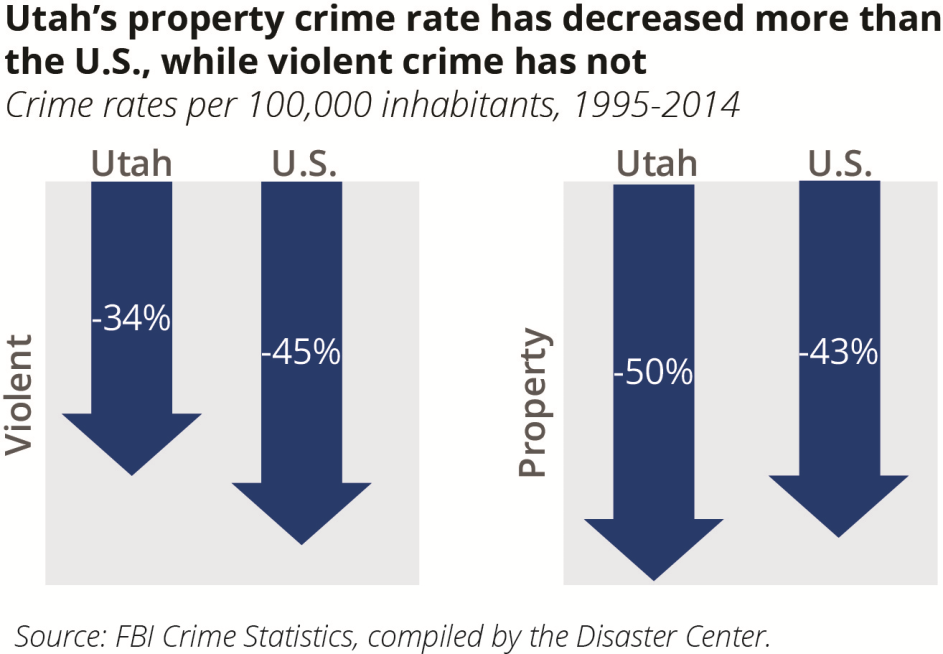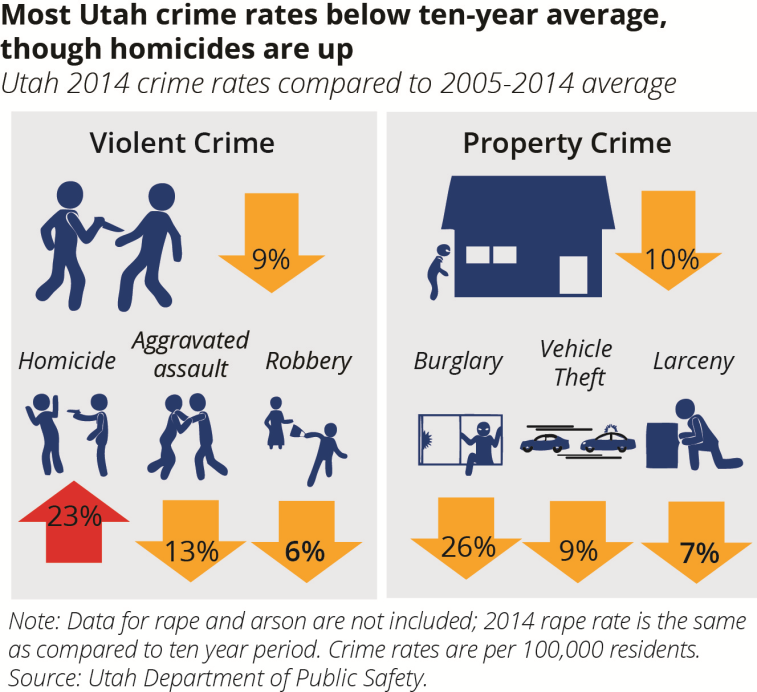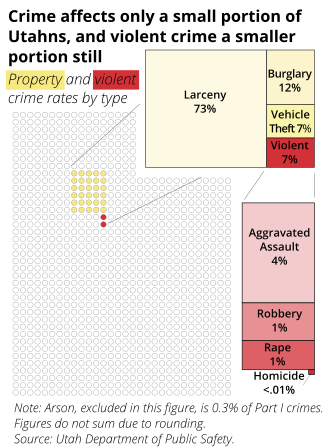In the 2016 Utah Priorities Project, crime ranked seventh among issues concerning Utahns. While sixth in 2004 and 2008, it dropped to twelfth for 2010 and 2012. However, the reemergence back on the top-ten list is not necessarily related to an increase in crime. In fact, violent crime and property crime rates remain at 50-year lows nationally and have been on a downward trend in Utah over the past 20 years.1
Survey Responses
Every two years, Utah Foundation creates the Quality of Life Index from a representative sample of Utahns. Since the first index in 2011, “safety and security from crime” has been considered the most important aspect in determining Utahns’ quality of life.2
In the Utah Priorities Project survey, nearly 56% of Utah voters expressed a high level of concern (a 4 or 5 on a 5-point scale) for crime. More women (62%) have a high level of concern about crime than men (49%). Half of Utah voters agreed that they are more worried about crime than they were five years ago, 
Violent and Property Crimes
This brief focuses primarily on “Part I” crimes, which consist of violent and property crimes. All other crimes (such as drug offenses and white collar crimes) are classified as “Part II.” Traffic violations have their own category.4 Overall, Part I crimes in Utah – and the U.S. – have been decreasing for decades.

In 2014 (the most recent comprehensive data available) there were 6,346 violent crimes and 84,711 property crimes in Utah.5 Usually measured per 100,000 inhabitants, these crimes equate to a violent crime rate of 216 and a property crime rate of 2,879.6
Violent crime rates have been decreasing in the Utah and the U.S. over the past two decades. While down by 34% in Utah, national violent crime rates have decreased by 45% since 1995,
Crime rates are affected by numerous factors, including density and size of population, socioeconomic status, effective strength of law enforcement, and even seasonal weather conditions.7 Not only are crime rates higher in urban areas (see the table in the endnote), voters on the Wasatch Front ranked crime as a higher concern than their more rural counterparts.8
Specific Crimes in Utah

Violent crime in Utah decreased by 4% from 2013 to 2014. Even though the number of homicides, rapes, and robberies increased in 2014, they were offset by a decrease in aggravated assaults which account for about three-fifths of all violent crime.9 Homicides jumped 10% in 2014, with 56 incidents of murder and non-negligent manslaughter. This homicide rate is 23% above the ten-year average. While it is the highest homicide rate since 2005, there does not seem to be an upward trend over time, and the 2014 homicide rate is still lower than any of the 1990s.
The number of property crimes decreased by 5% from 2013 to 2014. All types of property crimes decreased except for motor vehicle thefts. Burglary is the unlawful entry into a structure with the intent to commit a crime. These were down 16% in Utah over the period. Larceny is the unlawful taking of personal property. These were down by 3%. In Utah, nearly $100 million of property was stolen in 2014, with about 28% recovered. Of all the Part I crimes, larceny is far and away the most common, followed by burglary and motor vehicle theft, all of which are property crimes. (See the figure for details.)

In Utah, the “past month” illicit drug use rate was 7.3% among adults during 2013-2014, a full 2.5% below national usage.10 Utah had the seventh lowest rate in the country.11 The rate for illicit drug dependence or abuse is 2.6% among adults, though 6.1% for young adults aged 18 to 25 – which rates are similar to the rest of the nation.12 While not necessarily considered crimes, the misuse and abuse of prescription drugs in Utah has led to a 400% increase in overdose deaths over the past 15 years.13 Utah ranked 4th in the U.S. for prescription drug overdose deaths from 2012-2014, with an average of 24 Utahns dying from prescription drug overdoses each month.
Public Policy Approaches to Crime
Even with Utah’s decreasing crime rates, Utah’s policy makers are seeking further improvements. A criminal justice reform bill developed with the help of the U.S. Department of Justice and Pew Charitable Trusts was signed into Utah law in 2015. The law aims to avoid nearly all Utah’s prison growth over the next 20 years at a cost savings to the state totaling $500 million. It prioritizes prison space for violent offenders and implements comprehensive treatment and reentry programming for offenders. The bill reduces some drug possession convictions to misdemeanors and changes many misdemeanor violations to simple citations which are no longer subject to arrest or jail.14
In addition, Salt Lake County is implementing a Pay for Success program to reduce recidivism, particularly among the county’s homeless population. First Step House – a county-based non-profit organization – will be leading the provision of treatment services under the program. Using the Pay for Success model, the county is seeking $10 million from investors for these services. Depending upon the effectiveness of the program, investors will be repaid through savings of county justice costs. Effectiveness will be based upon comparing the recidivism and length of stay in jail for offenders that are served under the program against a similar group that does not receive program services.15
This research brief was written by Utah Foundation Research Director Shawn Teigen and Utah Foundation intern Fatema Ahad.
- ^ The Brennan Center for Justice, Crime in 2015: a Final Analysis, https://www.brennancenter.org/analysis/crime-2015-final-analysis (accessed on July 22, 2016). FBI Uniform Crime Reporting, Crime in the United States, http://www.ucrdatatool.gov/ (accessed on July 6, 2016).
- ^ Utah Foundation, Utah Foundation Quality of Life Index: 2015 – From concern about jobs to an embrace of natural surroundings, 2015.
- ^ The survey question is “I’m more worried about crime than I was five years ago.”
- ^ Utah Department of Public Safety – Utah Bureau of Criminal Identification, 2014 Crime in Utah Report, http://site.utah.gov/dps-criminal/wp-content/uploads/sites/15/2016/04/2014-CrimeinUtah04182016.pdf (accessed on July 5, 2016).
- ^ FBI Uniform Crime Reporting table, https://www.fbi.gov/about-us/cjis/ucr/crime-in-the-u.s/2014/crime-in-the-u.s.-2014/tables/table-5 (accessed on July 6, 2016).
- ^ FBI Uniform Crime Reporting table, https://www.fbi.gov/about-us/cjis/ucr/crime-in-the-u.s/2014/crime-in-the-u.s.-2014/tables/table-1a (accessed on July 6, 2016).
- ^ Utah Department of Public Safety, ibid.
- ^ FBI Uniform Crime Reporting table, https://www.fbi.gov/about-us/cjis/ucr/crime-in-the-u.s/2014/crime-in-the-u.s.-2014/tables/table-5 (accessed on July 6, 2016).
Crime Rates in Utah, per 100,000 individuals Violent Property Urban areas 219 2,990 Cities outside of urban areas 214 2,620 Non-urban counties and towns 170 1,413 Note: “Urban areas” are Metropolitan Statistical Areas.
Source: FBI Crime Statistics.
- ^ Utah Department of Public Safety, ibid.^ SAMHSA, Center for Behavioral Health Statistics and Quality, National Survey on Drug Use and Health, 2013 and 2014, Selective Drug Use tables, http://www.samhsa.gov/data/sites/default/files/1/1/NSDUHsaeUtah2014.pdf (accessed on July 8, 2016).According to the Substance Abuse and Mental Health Services administration: “Illicit Drugs include marijuana/hashish, cocaine (including crack), heroin, hallucinogens, inhalants, or prescription-type psychotherapeutics used nonmedically. Illicit Drugs Other Than Marijuana include cocaine (including crack), heroin, hallucinogens, inhalants, or prescription-type psychotherapeutics used nonmedically.”
- ^ SAMHSA, Population Data / NSDUH, http://www.samhsa.gov/data/population-data-nsduh/reports?tab=33#tgr-tabs-33 (accessed on July 15, 2016).
- ^ SAMHSA, Center for Behavioral Health Statistics and Quality, National Survey on Drug Use and Health, 2013 and 2014, Selective Drug Use tables, http://www.samhsa.gov/data/sites/default/files/1/1/NSDUHsaeUtah2014.pdf and http://www.samhsa.gov/data/sites/default/files/NSDUHsaeNational2014.pdf (accessed on July 15, 2016).
- ^ Utah Department of Health, Violence and Injury Prevention Program, http://www.health.utah.gov/vipp/topics/prescription-drug-overdoses/ (accessed on July 15, 2016).
- ^ Utah House Bill 348, 2015, http://le.utah.gov/~2015/bills/static/hb0348.html (accessed on July 26, 2016). Pew Charitable Trusts, Utah’s 2015 Criminal Justice Reforms Issue Brief, June 15, 2015, http://www.pewtrusts.org/en/research-and-analysis/issue-briefs/2015/06/utahs-2015-criminal-justice-reforms (accessed on July 13, 2016).
- ^ Salt Lake County, Pay for Success Criminal Justice webpage, http://slco.org/mayor/initiatives/pay-for-success/criminal-justice/ (accessed on July 28, 2016).


